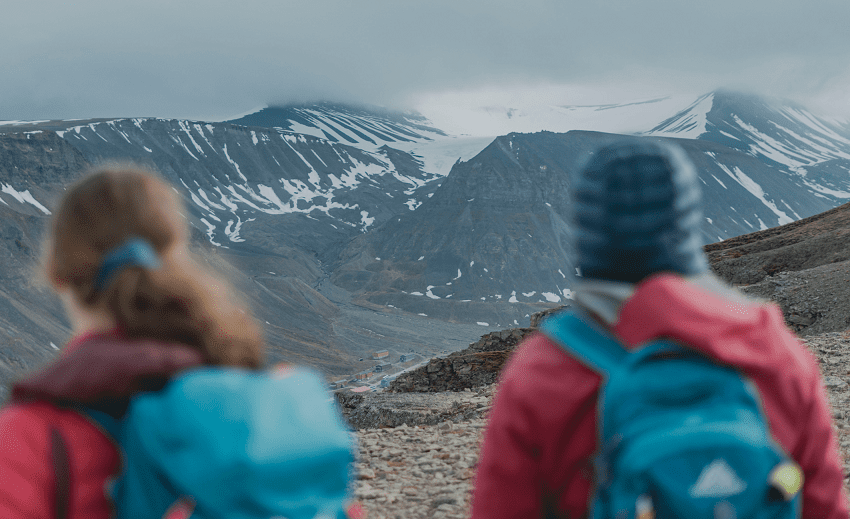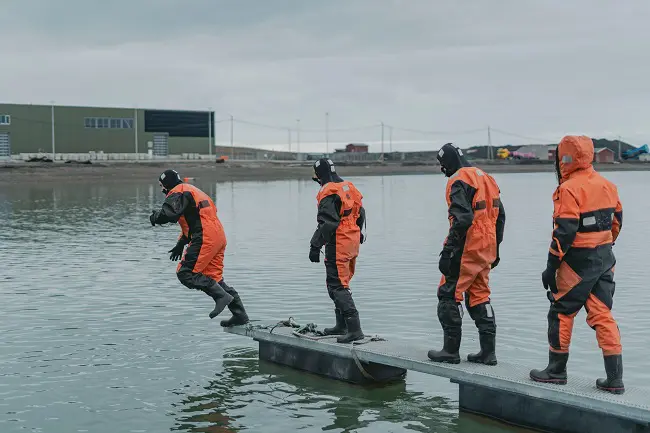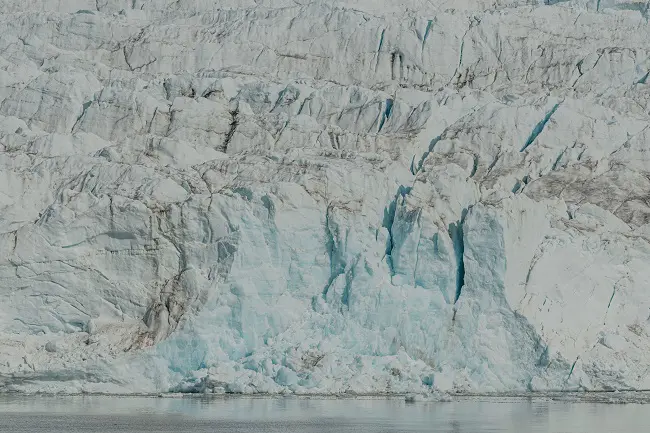The global Arctic
Around the summer solstice of 2022, a small group of twenty young researchers met in Svalbard, a small island lost between Norway and the North Pole. The Norwegian Academy of Polar Research wanted to bring us together around the theme of “The Global Arctic” to “identify and discuss points of connection within and between the natural, social and human sciences“.

The hike to the melting glaciers was as crucial as the lectures for the success of our project. Photo: Ragnhild Utne
Text: Ugo Nanni
We came from different academic backgrounds, from outside and inside the Arctic to search and research together. For most of us, this was the first time we set foot in the Arctic. During our stay, the height of the sun did not change that much, it was just travelling around us. Around the two cliffs on which lie the remains of the coal mines that have sustained the town for almost a century. With its 2,000 inhabitants, Longyearbyen is today mainly structured around Arctic tourism and its university centre, UNIS. This unique situation is a direct gateway to the Arctic, a region that is much more connected to the rest of the world than one might think. And often not in a good way.
Temperatures there have risen three to four times faster than globally and pollutants from around the world are accumulating and persisting for decades. What is happening in the Arctic shows us our future, and how people and communities are adapting to the effects of climate and environmental change sheds light on possible future adaptation paths. But learning from the Arctic requires good communication across disciplines that span beyond academia. This is what we have tried to do. Follow me on this journey across disciplines and knowledge.
Why does spending time together matter?
We spent 10 days together and, most importantly, we met agents of change, people who have been acting for more than 30 years at the interface between science and governance. With Grete, Bjørn, Thor, Lars-Otto and many others, we learned first-hand what interdisciplinarity really means. It is always something else to know that these people exist and to realise that the Arctic Council was created by one of them or that the first international law on the protection of polar bears was signed by one of those hands I shake every morning. Living with these people, having a cup of coffee and walking along the fjord, brings them into the same reality as ours. I am convinced that our reality is a matter of perception, and that knowledge alone is not enough. Without experiencing things, without feeling them, by sharing a coffee, a corner of the table or a walk with other people, it is very difficult to realise that they really exist. And this applies to climate change.
Today, access to knowledge is very easy, but access to the experience of that knowledge, to the emotion of knowing, is reduced. When I started my PhD, I thought that journalists, politicians and civil society would approach scientists on their own. I thought that knowledge would find its own way, but in the end it is not the physical access to knowledge that counts, but the perception of that knowledge. Perhaps this is why our society still does not see what a warming and melting world means, despite the clear statement of the scientific community. It is a question of perception and commitment. Even in Longyearbyen, a town at the heart of the change, perception issues are present and it took extreme events affecting the town to start creating global awareness of climate change. The book “My World is Melting” is a very good example of how direct experiences change the perception of climate change. Such experiences redefine our imaginary and what we think is possible. By ‘imaginary’ I refer to the system of meanings that govern our social structure. We questioned and shared our imaginary by spending time together and understanding each other, but this was not always easy.

The struggle to build a common imaginary
We all came from different backgrounds and had our own stories. We were all scientists, which should have facilitated collaboration. In interdisciplinary work, you have to adapt your language, to know who the other person is in order to know how to speak. Trying to understand where we are talking from and where the other person is talking from was the key to our exchanges. Working together means getting out of our mono-disciplinarity. We asked ourselves what we were looking for when we came here. Was it to have a wider audience to be more successful? Was it to get out of our routine to broaden our range of possibilities? Or simply out of curiosity? We did not find the answers, but that was part of the process. It may sound simple, especially for young researchers, but it is not. Even between people who are aware of the same cause and know the Arctic. It was not the first time I had been in such a situation, but it really highlighted how isolated we can be from each other, even within the academic world. So when it comes to talking to civil society, politicians or other experts, the challenge becomes much greater.
I thought that my way of thinking, my knowledge, was accessible to everyone, that what I am as a scientist, as a researcher, was not so complicated to understand. We use concepts for so many years that they become so familiar to us that we assume that everybody knows them. What we tried to do here was to understand how to share knowledge, how to link expertise and transfer our knowledge in a readable and understandable way. From a personal point of view, it was not only about writing an interdisciplinary paper, but also about a new way of looking at things. I am not saying it happened in a week, and I have been trying to navigate the interfaces for a decade while gaining expertise in my research area. Now I see what it really means to be an expert, to have legitimacy, and this interdisciplinarity has added meaning. It reminded me why I study glaciers. It reminded me that it is about sharing their stories, with you and with others.

Why interdisciplinarity is so important?
Since the Cartesian revolution, we have learned to put problems into boxes and treat them independently of each other, thinking that the whole is simply the sum of the parts. This is what we have done in academia, in industry, but also in our lives. It has allowed us to explore the unknown at an unprecedented level, to go further in all directions, again and more. It has allowed us to create tools and machines capable of things we could not have imagined only 20 years ago. But it has also made us sometimes forget the big picture, our connections with others and with the world. We have learned to disassociate ourselves from each other, and I am a prime example of this, as an expert in the physics of glacier sliding. Over the past decade, I have moved from one country to another on average every two years. I have gradually cut ties, created new ones, but above all I have specialised in a very firm field of scientific exploration. Sometimes I forgot the importance of links, and sometimes I gave too much importance to my scientific work. And that is where interdisciplinarity helped me.
Interdisciplinarity is not just about putting experts side by side and having them discuss and juxtapose their knowledge. It is about creating a different kind of knowledge. It is about accepting that the sum of the parts equals something different, something unexpected. To do this, we discussed the links between these parts and accepted their complexity. In the literal sense, that is, woven together. This word has been in my vocabulary for a long time, but these 10 days in the Arctic allowed me to find its full meaning, because we wove together. There are a lot of theories about how to make different disciplines work together, and I was inspired by reading about the organisation of social movements. The key to this was to listen to each other and accept our different languages while being aware of where we came from and why we are here. We all had our limits in terms of our emotional and personal involvement in this project. We accepted them and it was much easier to work together.
How did we train our interdisciplinarity?
Every morning we would go down the valley, leaving the glaciers behind and heading towards the fjord. And every evening we returned to our huts. We had a good thirty minute walk, a good time to meet each other, one by one. We got to know each other and work together during meals, hikes and discussions in small groups. The organisation of the summer school, with lectures in the morning and group work in the afternoon, gave us all the space we needed for interdisciplinarity. Conflicts have also been a good time to practice. We had some very tense moments, often due to a question of identity or language. These were opportunities to get to the heart of the matter of communication between us.
It would be an illusion to think that interdisciplinarity can be done without conflict, but conflict is not necessarily negative and has allowed us to let off steam sometimes. The long walks along the fjord in the gusts of wind often calmed us down. Each group had its own dynamics, each had its own way of doing things and the atmosphere could change from one work session to the next. I tried to navigate between these groups. I tried to capture the coherence of the project, to work on this common ground and build a shared imaginary. Bringing people together is not easy, it raises questions of legitimacy and humility. But it can take many forms, because a leader is not necessarily the one in the limelight. In the end, I think we all contributed in our own way, as far as we wanted to.
What is next?
Almost three months after that meeting, we are trying, despite the distance and time zones, to finish our joint project and submit it to the Journal of Polar Geography by the end of the year. Once we left Svalbard, once we were no longer in the same room, our lives and our daily lives caught up with us so quickly. Between those who go out into the field, those who finish their degree, those who change jobs or go on holiday, it is not easy to stay close and especially to work together. But somehow it continues, as if something has emerged during this summer school, making us work not only across our disciplines but also across the boundaries. Melting boundaries.
Ugo Nanni is a postdoctoral researcher at the University of Oslo. From the Alps to the Arctic, he listens to the whisper of glaciers. When he is not conducting research, he shares the voice of the glaciers and tells their story beyond the academic world. Ugo is also on twitter @NanniUgo and you can contact him at ugo.nanni@geo.uio.no. This text represent only the partial and personal view of the author on the summer school.
Further readings
- The David Graeber Institute, on working together to address the current crisis. It provides valuable insights into how our imaginations construct our society.
- The Arctic Monitoring and Assessment Programme, one of the six working groups of the Arctic Council, has successfully brought together Arctic researchers and citizens to address environmental challenges.
- A research group at University College of London working beyond interdisciplinary with extreme citizen science.
- Bruno Latour, a French socio-anthropologist who has studied the way in which scientific and technological studies are conducted.